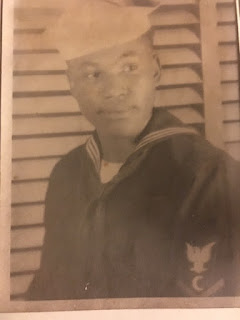 |
| Petty Officer Third Class Robert H. Goodwin, WWII veteran |
Topics: Nanofluidics, Nanotechnology, Research, STEM, Thesis
After many weeks of running experiments, parsing data and writing preliminary conclusions, I had to stand before my committee: my advisor (chemist) and my nano physics professor, the department chair (mechanical engineering) and defend my research. In hindsight, it was the committee on steroids.
I bought coffee and donuts; water for the committee as is the tradition. That exposed me to 95 degree heat and North Carolina humidity. I ended up defending without my suit jacket.
There is the public defense part where you get questions from either the panel or the audience. Then the grueling begins when the audience is encouraged to leave and you are alone with your committee.
I was challenged on my understanding of the data, not in an accusatory way but to foster a better rewrite when I turn in my written product to the Graduate College. Those are due next Wednesday. I should be able to fulfill that request on review with my advisor. The committee also suggested further experiments I could do to verify what I thought I was seeing. After an intense 40 minutes of questioning, I was asked to leave as the committee conferred. For what seemed like an eternity, my advisor came out and shook my hand: "congratulations." I then went in to the committee to get their final suggestions and signatures for completing the process.
I am also moving...within Greensboro mind you, but to a house we own outright versus a rental apartment we don't.
It reminded me of my father proudly burning the last payment record as we owned our modest home - two bedrooms, one bath and less than a thousand square feet - in East Winston-Salem off Cleveland Avenue.
For the move, I had to parse through memorabilia that traveled with us from Texas to New York to North Carolina. It was time to make some decisions.
I found the program and invitation to my mother's graduation from Practical Nursing School in Philadelphia, Pennsylvania. I imagined the trip for her and my father probably took a lot of back roads and the Green Book during that time period.
I found my parents' invitations sent for my high school graduation as well as my acceptance letter saying I had been accepted to North Carolina A&T State University for the fall semester, 1980. I found my first karate promotion certificates from Dr. Casterlow as part of the A&T Dojo.
I found a short story my father kept I had written for catharsis called "The Decision." It was when Pop left it to me to decide the fate of my dog, a Cocker Spaniel named Fala, named after FDR's dog. He was aged, tired and had stopped eating. The gist of the story was "sometimes as a man, you have to make difficult decisions." I was twelve. I didn't own a dog again until I was an adult with sons of my own. Parting with each four-legged friend has never gotten easier.
I found a lot of family photos that will go in albums and on a flash drive soon.
I also found the corroborating evidence I had read on History.com: the GI Bill like the New Deal before it was discriminatory to African Americans. My father passed a college entrance exam with only a sixth grade education formally, due to the fact he and my uncle Moses, Jr. went to work for my grandmother to help out the household. The GI Bill for white soldiers and sailors paid for a college education and loans encouraging home ownership, building a wealth gap that has persisted for generations. Many white service members went on to become professionals and professors. The GI Bill for my father and his fellow WWII veterans of color only covered vocational training, like barber school. So that's what he learned. Pop often cut my hair in the kitchen of our home in a segregated neighborhood crafted by redlining legislation. He faced the indignities of working for a textile company - routinely getting passed over for promotions and getting called "boy" or n-word then his name. He smoked in a chair in his bedroom before he engaged with the family every evening after work. That was his way of coping. It eventually led to lung cancer, the contributing cause of his death.
I sadly had to throw away his literature books he bought for me: I read The Iliad and the Odyssey from that collection. I read snippets of Milton and I meant to read Thomas Paine. They alas were molded and mildewed; unrecoverable. I plan to replace the collection once we're settled in.
Announcing the good news on Facebook numbered in the thousands on the Kappa Alpha Psi page; hundreds on my main feed. It was good to see others, near and far, celebrate this achievement with me.
I passed my Masters Thesis defense.
I like to think I redeemed my father's dreams as well.
